Cygnus NG-15
Human Spaceflight
Related resources
Cygnus NG CRS-15 Resupply Flight to the ISS
For the NG CRS-15 mission, the Cygnus spacecraft will deliver approximately 3,800 kg of cargo to the space station. Cygnus is comprised of two primary components, the Pressurized Cargo Module and the Service Module. In keeping with company tradition, each spacecraft is named after an important figure in the aerospace industry. 1)
Northrop Grumman is honored to name the NG-15 Cygnus spacecraft after Katherine Johnson, a NASA mathematician and Black woman who broke through barriers of gender and race, and whose work was critical in sending the first Americans into space. Katherine Johnson was born on August 26, 1918 and died on February 24, 2020 at the age of 101. During her 35 year career at NASA, she calculated the orbital mechanics and trajectories of various US missions to space, such as Alan Shepard's first mission to space and John Glenn's first flight to orbit. Furthermore, she worked on the rendezvous of the Apollo lunar module and command module and her calculations were essential for the Space Shuttle program. Kathrine Johnson's work was honored by a variety of awards and medals. In 2015, Johnson received the highest civilian award in the United States, the Presidential Medal of Freedom. In 2016, she received NASA's Silver Snoopy award, followed by the Congressional Gold Medal in 2019. With her work, she inspired generations of African American women and paved the way for desegregation in the 1950s and 1960s.
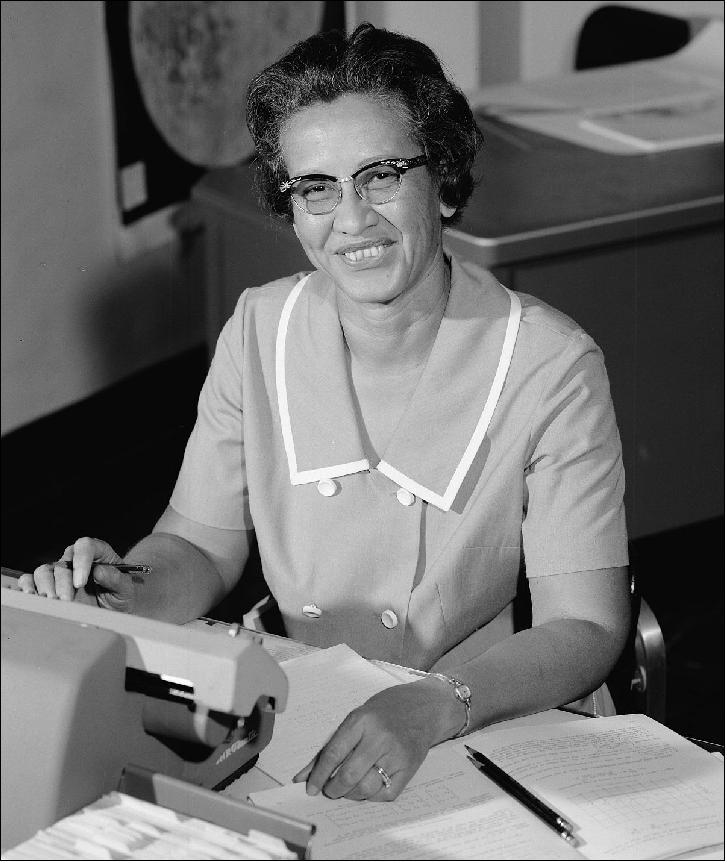
The S.S. Katherine Johnson will be launched into orbit using an Antares 230+ rocket from Virginia Space's Mid-Atlantic Regional Spaceport (MARS) Pad 0A on Wallops Island, Virginia. Northrop Grumman will once again load critical cargo into Cygnus 24 hours before the scheduled launch.
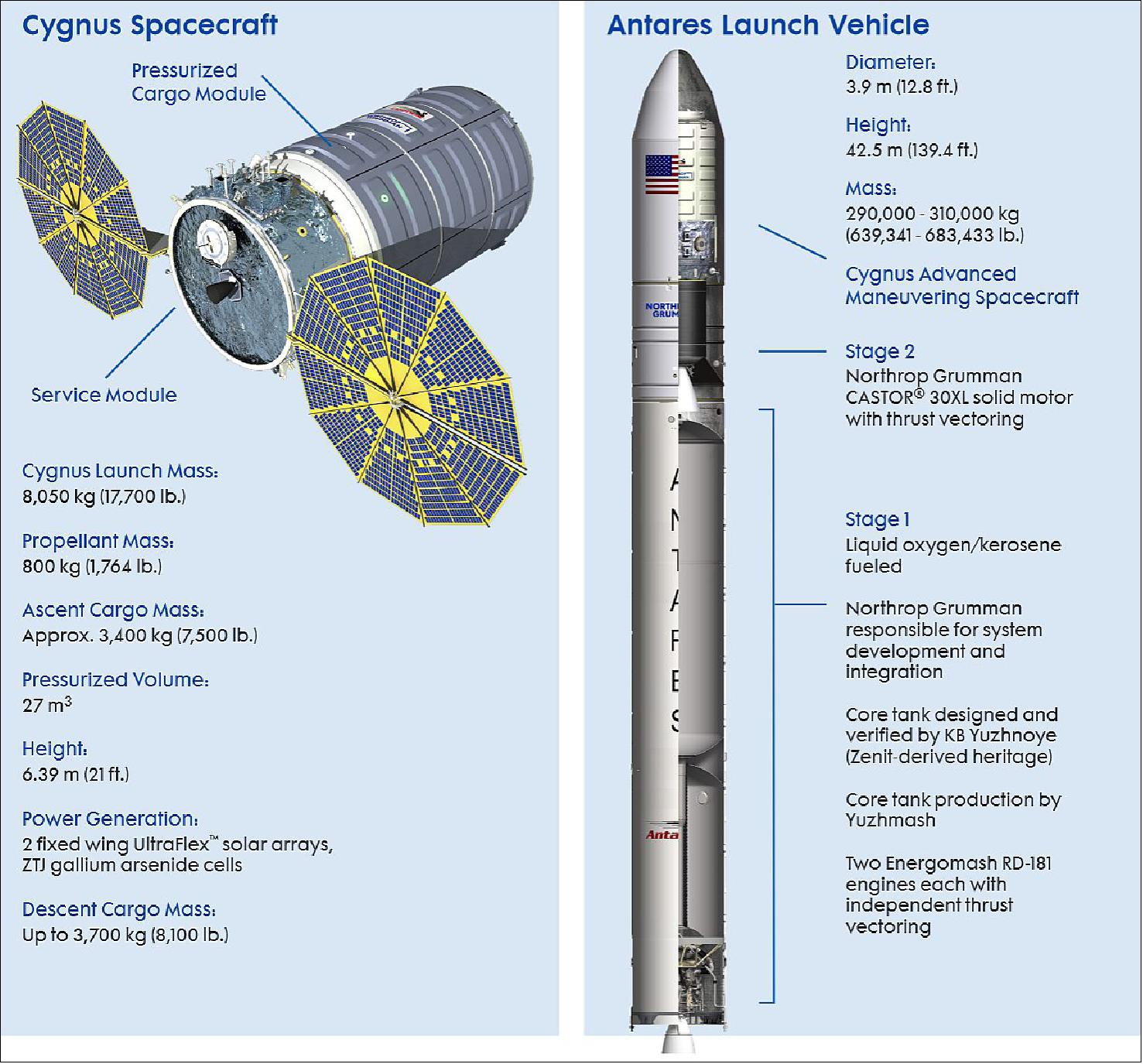
Launch
NASA commercial cargo provider Northrop Grumman launched its Antares 230+ vehicle Cygnus CRS-15 on Feb. 20, 2021 (17:36 UTC, 12:36 p.m. EST) from MARS (Mid-Atlantic Regional Spaceport) on Wallops Island, VA, the 15th resupply mission to the International Space Station. 2) 3) 4)
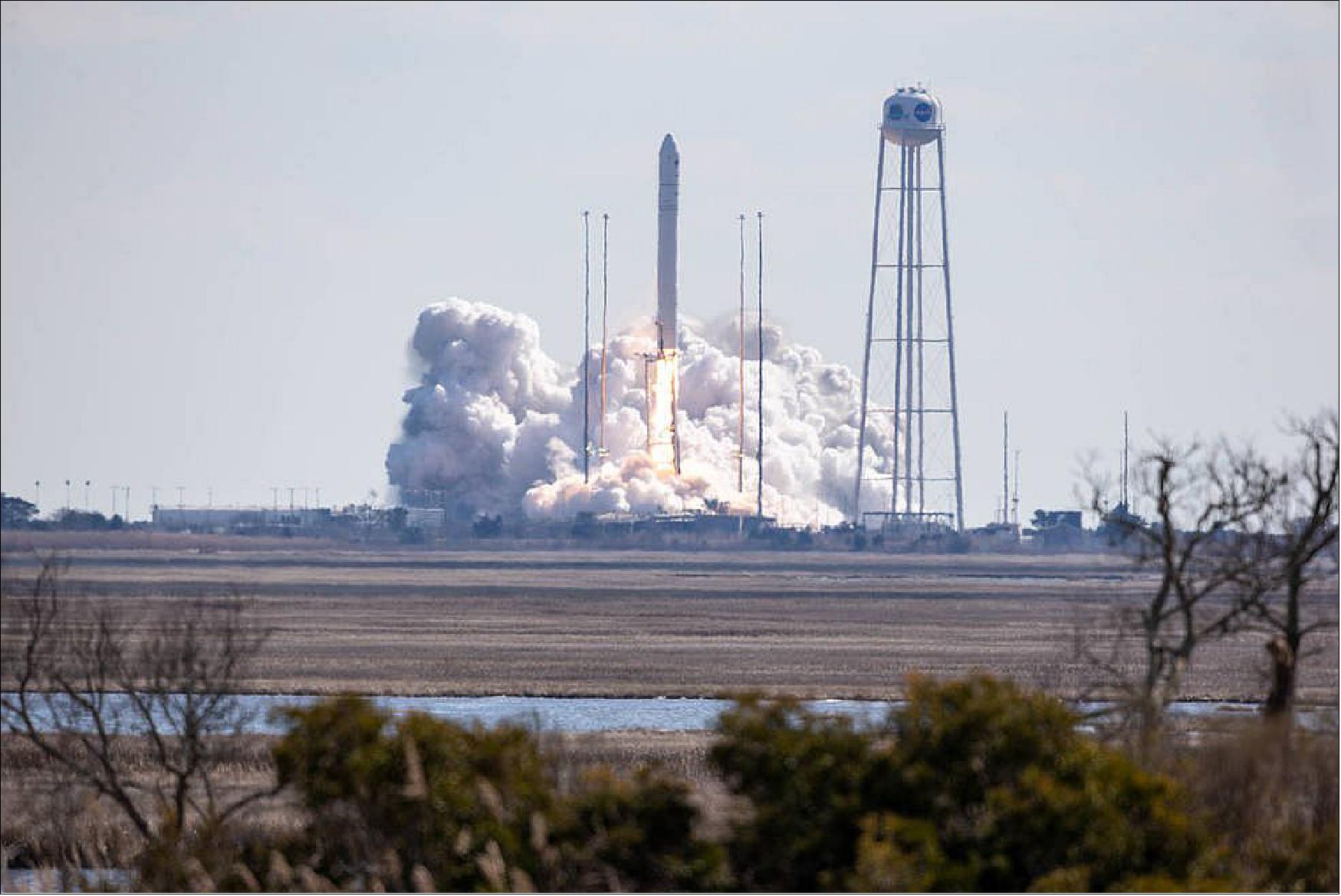
Orbit: Near circular orbit, altitude of ~ 400 km, inclination = 51.6º, period of~92 minutes.
The Cygnus spacecraft, dubbed the SS Katherine Johnson, will arrive at the space station Monday, Feb. 22. About 4:40 a.m., Expedition 64 Japan Aerospace Exploration Agency astronaut Soichi Noguchi will capture Cygnus, with NASA astronaut Michael Hopkins acting as a backup. After Cygnus capture, mission control in Houston will send ground commands for the station's arm (Canadarm 2) to rotate and install it on the station's Unity module Earth-facing port.
The Cygnus spacecraft will remain at the space station until May before it disposes of several thousand pounds of trash through its destructive re-entry into Earth's atmosphere.
Some Payloads on Flight Cygnus NG-15
Of note, the ISS National Lab is sponsoring a number of technology development payloads on Northrop Grumman CRS-15. By supporting technology development investigations on the orbiting laboratory, the ISS National Lab serves as a business incubator in space, enabling advancements not possible on Earth that help to drive a robust and sustainable market in low Earth orbit. Additionally, insights gained from such projects can be used to improve products and processes that will produce positive economic impact. Below are some of the investigations sponsored by the ISS National Lab that are launching on Northrop Grumman CRS-15. 5)
Highlights of space station research facilitated by this Cygnus mission are:
• Spaceborne Computer-2, a high-performance commercial off-the-shelf computer system being studied to increase data processing speeds for science aboard the space station.
- In 2017, engineers from Hewlett Packard Enterprise (HPE) launched a high-performance computer, called the Spaceborne Computer, to test whether a commercial off-the-shelf computer system without any hardware modifications could operate seamlessly in the extreme conditions of space. Based on this success, the team will now launch its second iteration of the Spaceborne Computer—this time delivering twice the computational power and providing in-space data processing capabilities. Using Spaceborne Computer-2, researchers may see improvements in the ability to process and analyze data onboard the ISS rather than sending the data back to Earth for analysis, enabling faster results and greater potential for in-space iteration of research.
- Spaceborne Computer-2 High Performance Commercial Off-The-Shelf (COTS) Computer System on the ISS (Spaceborne Computer-2) builds upon the successes of Spaceborne Computer, exploring how commercial off-the-shelf computer systems can advance exploration by processing data significantly faster in space with edge computing and artificial intelligence (AI) capabilities. Spaceborne Computer-2 further tests additional techniques for recovering or mitigating errors in the extreme environment of unprotected solar radiation, galactic cosmic radiation (GCR) and other events. Additionally, Hewlett Packard Enterprise (HPE) works with the space community and the International Space Station-National Laboratory (ISS-NL) to test and demonstrate that current Earth-based data processing of ISS experimental data can be performed onboard during the anticipated 24 to 36 month mission of Spaceborne Computer-2.
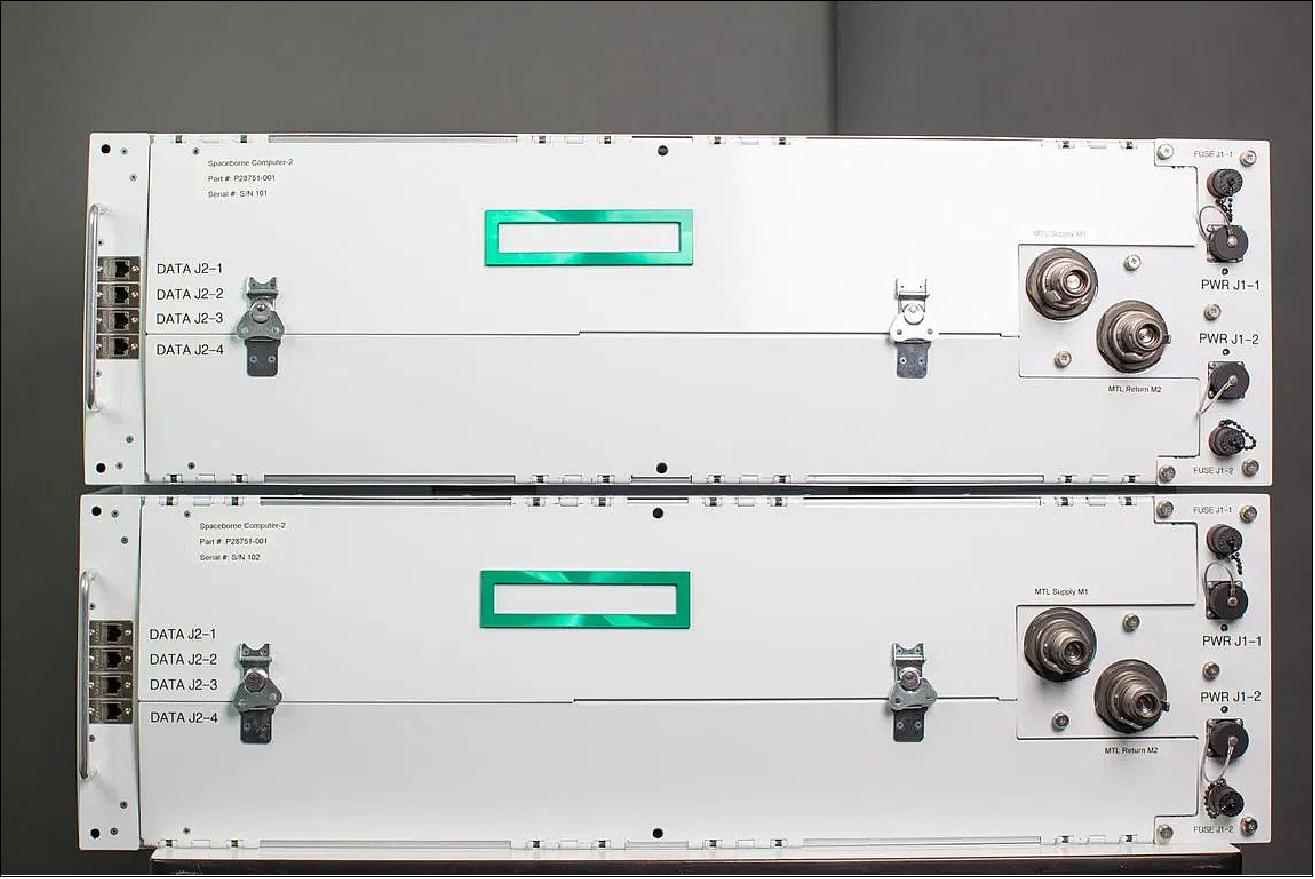
• Crystals grown in microgravity are often larger and more well-ordered than Earth-grown crystals—and over the years, crystal growth has been an important area of research on the ISS. On this mission, Redwire will launch its Industrial Crystallization Facility(ICF), the sixth commercial facility the company has developed for testing and use on the ISS. The ICF will provide a space-based platform for the growth and formulation of centimeter-scale single crystals and other exotic materials for use in the optics and sensor industries. Validation of the ICF will also provide a proof of concept for applied industrial materials production in microgravity, which will be an important in-orbit research and development capability in the future.
• Three separate investigations launching on this mission will utilize the MISSE Flight Facility—a platform operated by Alpha Space on the exterior of the ISS that exposes samples to the harsh space environment, which includes extreme temperature variations, enhanced radiation levels, and atomic oxygen. These investigations include an agricultural investigation evaluating the effects of the space environment on barley seeds, an academic study examining how phosphor powders and composites react in space, and a private-sector experiment testing the durability of 3D printed radio frequency circuits in space for potential use in future small satellites.
• LambdaVision's, second experiment headed to the space station to study the advantages of manufacturing artificial retinas in space
Micro-16, an investigation studying muscle strength changes in worms to help us better understand muscle weakening that astronauts can experience in microgravity
• Micro-16, an investigation studying muscle strength changes in worms to help us better understand muscle weakening that astronauts can experience in microgravity.
- To figure out if decreased expression of muscle proteins is associated with muscle weakening, researchers study C. elegans worms moving around a microscope slide filled with rubber pillars. Researchers can then determine the strength of the worms by how much force they apply to the pillars while moving around. The results could also support new therapies targeting age-related muscle loss on Earth.
• The Real-Time Protein Crystal Growth-2 experiment, which will demonstrate new methods for producing high-quality protein crystals in microgravity. The structure of protein crystals is often closely related to their function in the human body. Therefore, growing protein crystals and studying their structures often leads to understanding the function and effects of it. While on Earth, protein crystal growth is often difficult to achieve, due to Earth's gravity interfering, whereas the microgravity environment on the ISS negates gravity from the equations. Researchers hope to get a better understanding of growing protein crystals to identify possible targets for future drugs to fight certain diseases.
• A-HoSS (Artemis HERA on Station), a radiation detection system developed for the Orion spacecraft and certified for use on NASA's Artemis II mission, the first mission on which a crew of astronauts will orbit the Moon in the spacecraft. The HERA (Hybrid Electronic Radiation Assessor) was modified for the use on the ISS and will have to operate for at least 30 days without any errors to validate the system for crewed flight in upcoming Artemis missions. It will first be put to use on the Artemis II mission that will orbit the Moon.
• Exploration ECLSS: Brine Processor System, a demonstration in regenerative life support technology that will help provide more clean air and water to the space station crew. The objective is to demonstrate recovery of additional water from the Urine Processor Assembly in order to further increase the current percentage of recoverable water on the ISS. In order to achieve the 98% of water recovery that is needed for long-duration crewed exploration missions, the brine processor's dual membrane bladder allows water vapor to pass through while filtering out contaminants.
- The ECLSS (Environmental Control and Life Support System) was developed by Paragon Space Development Corporation (Paragon) with HQs in Tuscon, Arizona. Paragon's brine processing technology - which is vital to generating water for the crew of a spacecraft, space station or potential transport to or habitation on the Moon or Mars - represents a ground-breaking innovation that will be critical to long-duration human spaceflight missions. 6)
- While essentially used to recover water from urine, Paragon's Brine Processing System is notable in that it will increase the level of recoverable water in the current systems on the ISS by using a dual membrane that allows water vapor to pass through while filtering out contaminants.
- "This technology is essential to long-term spaceflight operations and even future stays on other planetary bodies - and if we're serious about going to Mars, demonstrating the feasibility and success of this system is critical. Understanding the need to squeeze every bit of recovery and efficiency from systems with energy and space constraints - like any spacecraft - is crucial in deep space exploration!" said Grant Anderson, Paragon's President and CEO.
- "Paragon is in the business of technological innovation, engineering solutions and scientific advancement - and our Brine Processing System exemplifies our business. This is a game-changer and we look forward to supporting NASA on the next challenge!"
- The water recovery rate of systems currently used on orbit is between 75-90% - but long-duration missions require a level of approximately 98%. And while there is currently no state-of-the-art technology in brine processing that can meet this requirement, Paragon's system is expected to achieve this target.
- Paragon's system will undergo a one-year demonstration period to prove viability and success.
• With the Protein-Based Artificial Retina Manufacturing experiment, LambdaVision aims to evaluate an artificial retina manufacturing system on their second flight to the ISS. This manufacturing system uses a light activated protein to replace the function of damaged cells in the eye. LambdaVision hopes to "gather more critical information on the overall design of the system and influence of microgravity on the layering process, as well as the necessary controls required to support good manufacturing processes." – Nicole Wagner, Ph.D., president and CEO of LambdaVision.
• Dreams: Astronauts often report sleeping better while being on the International Space Station than while being on Earth. ESA's (European Space Agency) Dreams experiment will add one step to the astronauts' night routine, a Dry-EEG headband. This EEG will serve as a technology demonstration, as well as a way to monitor the sleep quality during long-duration missions. Researchers can then analyze the results with direct feedback from the astronauts. Overall, a better understanding of sleep in microgravity adds to the better understanding of human health in microgravity.

ELaNa 33 (Educational Launch of Nanosatellites-33) Deployed CubeSats from ISS
• IT-SPINS (Ionospheric-Thermospheric Scanning Photometer for Ion-Neutral Studies), a 3U CubeSat developed and operated by students of Montana State University at Bozeman, Montana, externally deployed by Cygnus spacecraft. IT-SPINS provides 2D tomographic imaging from a 3U research CubeSat, addressing the basic nature of the nocturnal ionosphere. This 6-month mission aims to strengthen our fundamental understanding for development of ion gradient structures in the topside of the Earth's ionosphere and secondarily within regional phenomena such as equatorial plasma bubbles (EPBs) or polar patches.
- The IT-SPINS CubeSat was selected for launch by NASA's CubeSat Launch Initiative (CSLI) as part of the Educational Launch of Nanosatellites-33 (ELaNa-33) mission complement, sponsored by the NASA Launch Services Program (LSP).
• Slingshot and Nanoracks deployer: a number of CubeSats will be released via Slingshot and Nanoracks deployers, including Dhabisat, the second CubeSat developed by Khalifa University in Abu Dhabi, United Arab Emirates. Dhabisat was developed as part of Khalifa's Space Systems and Technology Concentration, a joint program established in 2015 with UAE-based satellite operator Al Yah Satellite Communications Company (Yahsat) and Northrop Grumman.
• Launching aboard Antares with Cygnus will be 42 ThinSats as part of a STEM outreach program for grades 4-12 by the Virginia Commercial Space Flight Authority. 7)
- The Antares launched ThinSats into very low Earth orbit Feb. 20 to gather data for one to five days before reentering Earth's atmosphere.
- "We received Globalstar data in the first 11 minutes after deployment over the remote region of South Atlantic Ocean," Matt Voss, NearSpace Launch chief operations officer, told SpaceNews. "NearSpace Launch and Virgina Space are still doing analysis of mission results and diagnostic of the STEM mission."
- The very low Earth orbit where ThinSats were deployed is important for climate research and space weather forecasts but difficult to study because of the high levels of atmospheric drag satellites experience, Hank Voss, NearSpace Launch co-founder and ThinSat inventor, said in a statement.
• On board the Cygnus will be three spacecraft belonging to Spaceflight customers, including Gunsmoke-J of LANL (Los Alamos National Laboratory)and two undisclosed U.S. government payloads. The Gunsmoke-J is a Joint Capability Technology Demonstration executed by the U.S. Army Space and Missile Defense Command, sponsored by both the Office of the Under Secretary of Defense (Research and Engineering) and the U.S. Army. This science and technology effort will demonstrate an entry-level capability in a 3U form factor relevant to Army warfighter needs and will also help inform future acquisition decisions. 8)
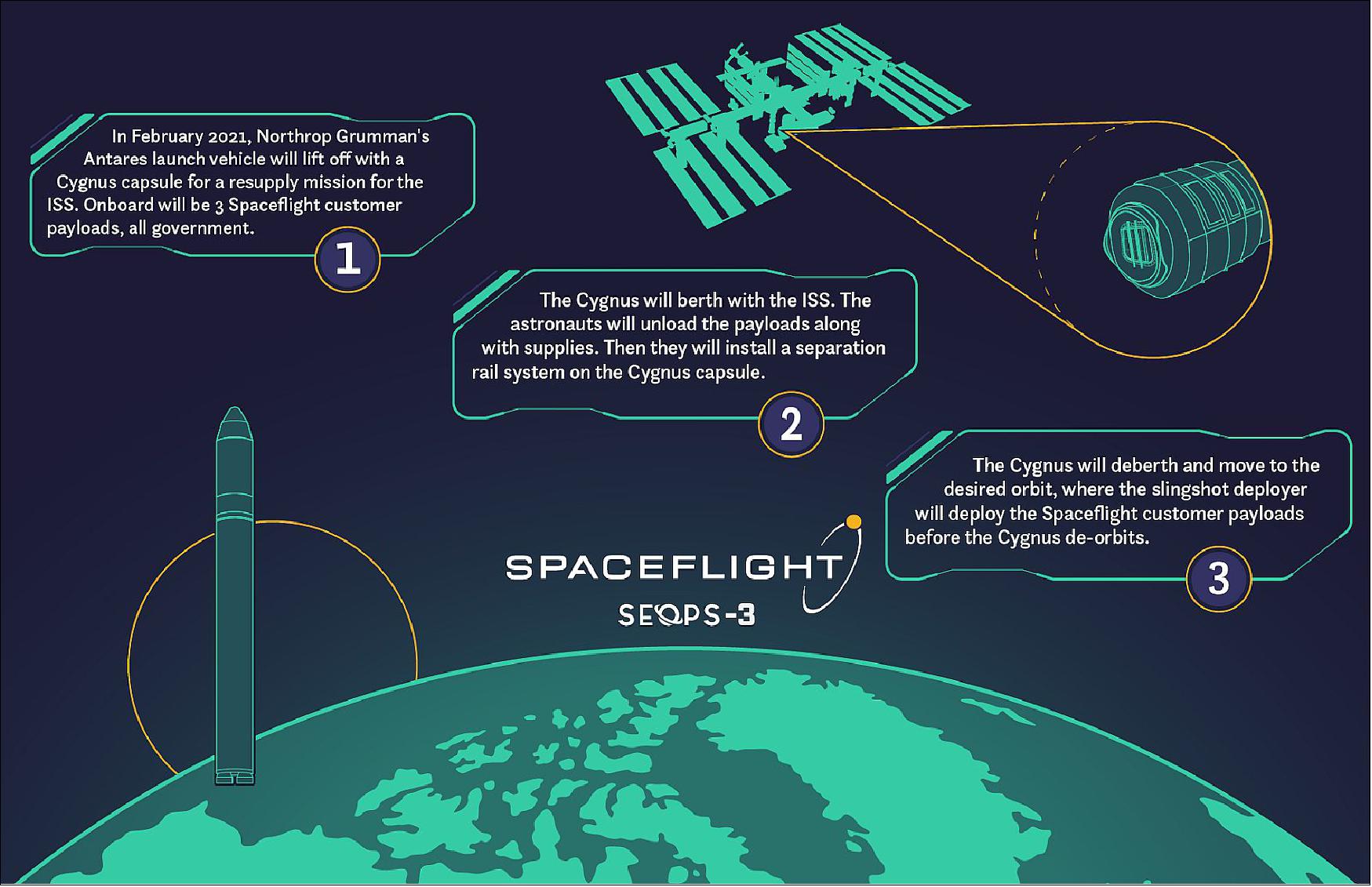
• TSURU, a technology demonstration CubeSat of Kyushu Institute of Technology, Japan.
• MAYA 2, a technology demonstration CubeSat of Kyushu Institute of Technology, Japan.
• GuaraniSat-1, a technology demonstration CubeSat of Kyushu Institute of Technology and the Paraguayan Space Agency.
• TAU-Sat1 (Tel Aviv University Satellite1), a 3U CubeSat of Tel Aviv University, Israel with a mass of ~2.5 kg. TAU-Sat1 Israel launches research nanosatellite to measure radiation in space. 9)
- TAU completed the construction of "TAU-SAT1" about four months ago and sent it for pre-flight testing at the Japanese space agency JAXA. About two weeks ago, the nanosatellite arrived at its final stop prior to liftoff: Wallops Island in Virginia, where it "caught a ride" on a NASA resupply spacecraft destined for the International Space Station.
- The data it collects will help scientists design protective equipment for astronauts and space systems, which can be easily damaged by cosmic radiation. According to Meir Ariel, director of TAU's Center for Nanosatellites, "Our scientific task is to monitor this radiation, and to measure the flux of these particles and their products."
Cygnus CRS NG-15 Resupply Ship at the ISS
• February 22, 2021: The Northrop Grumman Cygnus cargo spacecraft was berthed to the International Space Station's Earth-facing port of the Unity module at 7:16 a.m. EST Monday morning and subsequently bolted into place. Cygnus will remain at the space station until May, when the spacecraft will depart the station. Following departure, the Cygnus will dispose of several tons of trash during a fiery reentry into Earth's atmosphere. 10)
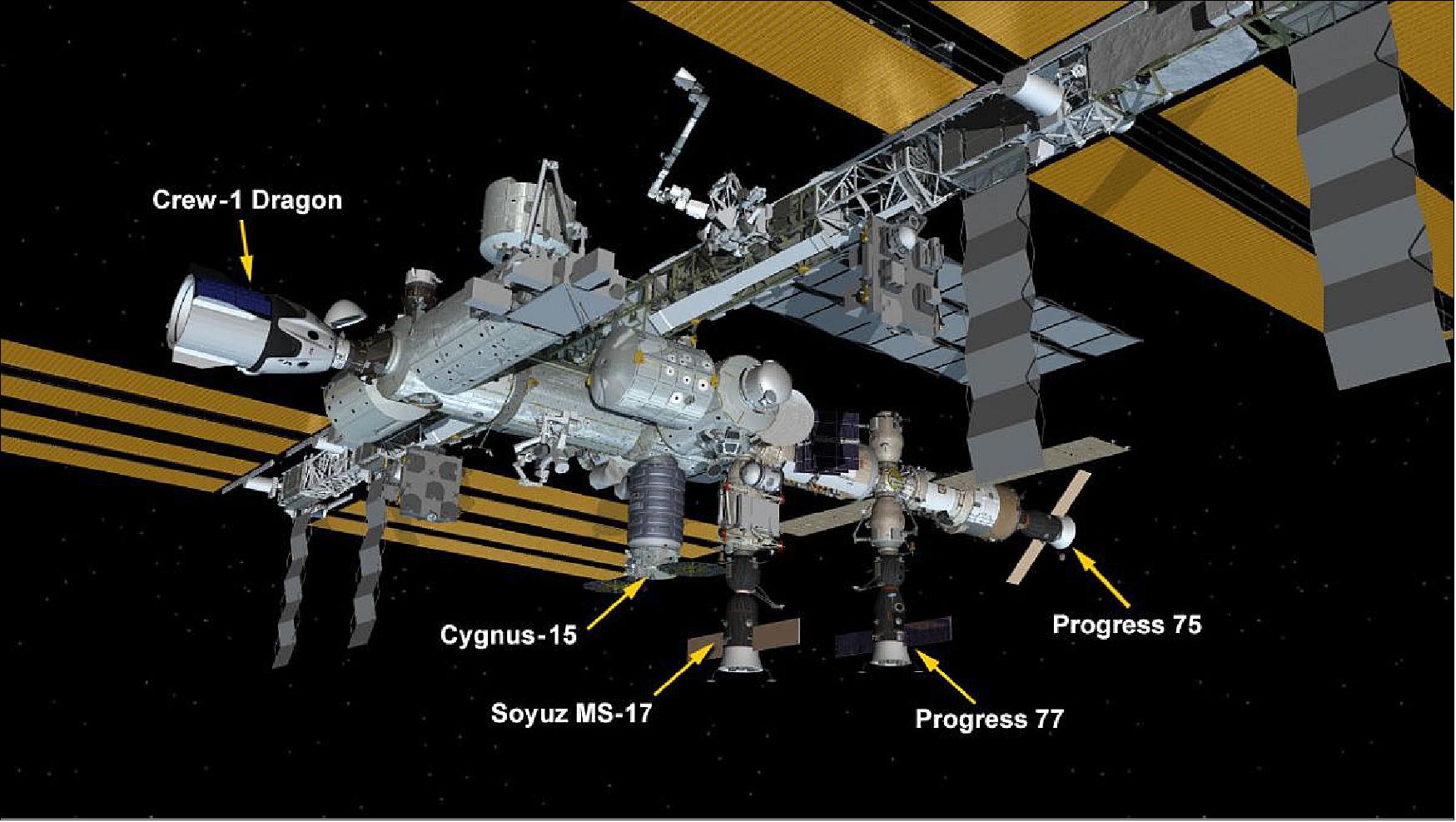
• February 22,2021: At 4:38 a.m. EST, Expedition 64 Flight Engineer Soichi Noguchi of the Japanese Aerospace Exploration Agency used the International Space Station's robotic Canadarm2 to grapple the Northrop Grumman Cygnus spacecraft as Flight Engineer Michael Hopkins of NASA monitored Cygnus systems during its approach. Next, ground controllers will command the station's arm to rotate and install Cygnus, dubbed the S.S. Katherine Johnson, on the Earth-facing port of the station's Unity module.
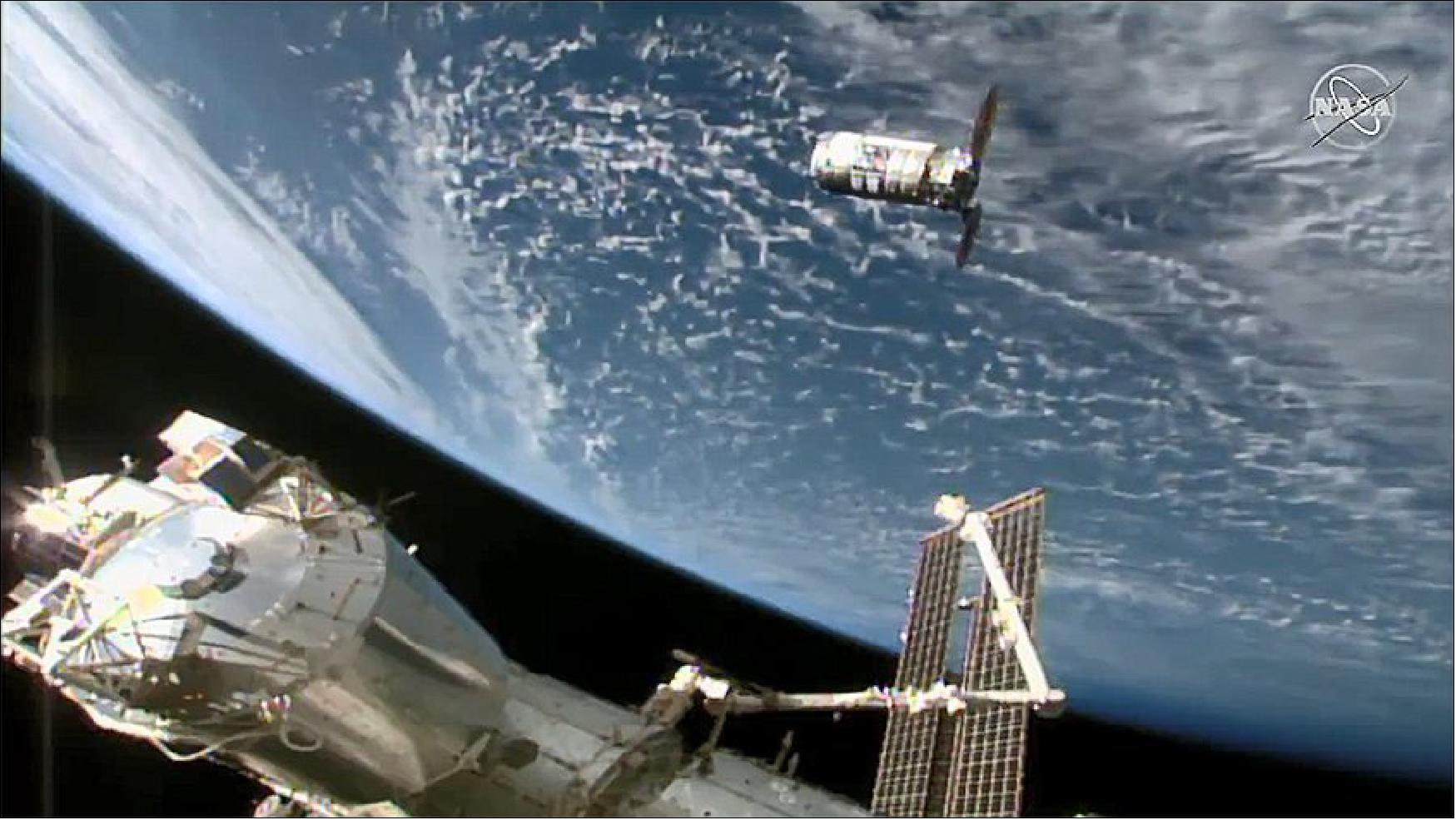
Descriptions of Systems/Items (provided after launch)
• August 18, 2021: After completing the first round of experiments on the International Space Station's second-generation Spaceborne Computer, Hewlett Packard Enterprises (HPE) and Microsoft executives say they are clearly demonstrating the value of processing data in orbit and funneling it into the cloud. 11)
- "We absolutely see the need for compute at the edge in space," Mark Fernandez, HPE Spaceborne Computer-2 principal investigator, told SpaceNews. "When we can accelerate data to insight, we can accelerate the benefits to mankind."
- Four experiments focused on quantum computing, security, healthcare and life sciences have been conducted with the assistance of the Spaceborne Computer-2, which has been on the space station since February. Another 29 experiments are in the pipeline, but more could be added during the Spaceborne Computer-2 experiment, which is scheduled to run for two to three years.
- Historically, on-orbit processing has been a challenge. Hardware and software custom-built for spacecraft computers tended to offer far lower processing speeds and less memory than computers manufactured for terrestrial applications.
- Traditionally, bandwidth to transmit data from space to the ground was another constraint, making it hard to run algorithms in space and send the resulting data to the ground.
- With the Spaceborne Computer-2 linked to Azure, "you can compute the results in orbit," said Tom Keane, Microsoft Azure corporate vice president.
- HPE is eager to prove that conventional supercomputers with open-source software can serve a variety of space-related customers including principal investigators conducting space station research.
- "It's the same technology and tools a developer would use," Fernandez said. "The hardware and software are right off the factory floor."
- One of the experiments completed on the Spaceborne Computer-2 involved genomics. To understand the impact of spaceflight on astronauts, principal investigators gathered and processed data on the Spaceborne Computer-2 before sending them to Microsoft's Azure cloud to compare them with public datasets.
- Without a space-based supercomputer linked to the cloud, investigators may have waited days, weeks or months to download the genomics data. By processing them on the Spaceborne Computer-2 linked to Azure, we were able to get them down in minutes, Fernandez said.
- Through the Spaceborne Computer-2 program, HPE and Microsoft want to demonstrate the utility of supercomputers linked to the cloud not only for space but also for remote terrestrial applications.
- "I always tell my colleagues that if we can prove it in space, we can do it on Earth," Fernandez said.
• June 29, 2021: S.S. Katherine Johnson completes a four month stay at the station. 12)
- Northrop Grumman Corporation (NYSE: NOC) announced today that its Cygnus spacecraft left the International Space Station to begin the next phase of the NG-15 mission. Cygnus was released by the station's robotic arm at 12:32 p.m. ET, carrying more than 8,000 pounds of disposable cargo. Cygnus will remain in orbit for approximately three days to carry out the secondary phase of the mission.
- The S.S. Katherine Johnson will now deploy five CubeSats via two separate CubeSat deployers, Slingshot and Nanoracks. This CubeSat deployment includes Dhabisat, the second CubeSat developed by Khalifa University in Abu Dhabi, United Arab Emirates. Dhabisat was developed as part of Khalifa's Space Systems and Technology Concentration, a joint program developed in collaboration with UAE-based satellite operator Al Yah Satellite Communications Company (Yahsat) and Northrop Grumman.

- "Our Cygnus cargo resupply missions to the International Space Station help enable humans to live and work in space," said Frank DeMauro, vice president and general manager, tactical space systems, Northrop Grumman. "With each mission, we grow our capabilities beyond cargo resupply as we operate a high performing science laboratory for both civil and commercial companies during the secondary phase of our flight."
- The NG-15 Cygnus spacecraft was launched on Feb. 20 aboard Northrop Grumman's Antares rocket, carrying nearly 8,000 pounds of scientific research, supplies and equipment to the astronauts living on the station. The vehicle has been berthed with the orbiting laboratory since Feb. 22.
- Northrop Grumman solves the toughest problems in space, aeronautics, defense and cyberspace to meet the ever evolving needs of our customers worldwide. Our 90,000 employees define possible every day using science, technology and engineering to create and deliver advanced systems, products and services.
• May 7, 2021: The space station is also a powerful platform for technology demonstration. Yesterday, Spaceborne Computer-2, from Hewlett Packard Enterprise (HPE), began operations onboard the ISS. Spaceborne Computer-2 is the next step following a previous technology demonstration from HPE focused on providing affordable commercial computing in space. To ensure successful installation of Spaceborne Computer-2, HPE worked in coordination with NASA to launch an additional spare part on the SpaceX Crew-2 mission in late April. 13)
- This second iteration of the Spaceborne Computer, which is comprised of the HPE Edgeline Converged Edge system and HPE ProLiant server, has twice the computational power of its predecessor and introduces artificial intelligence capabilities. NASA and ISS National Lab researchers will be able to use Spaceborne Computer-2 for in-space data processing and analysis to achieve quicker results and enable potential iteration of experiments on the ISS. Additionally, HPE has opened a call for solicitations on novel ways to leverage Spaceborne Computer-2 during its mission on the orbiting laboratory.
• February 22, 2021: Nanoracks Launches Two CubeSats on Cygnus NG-15 14)
This launch is Nanoracks' ninth mission providing opportunities for CubeSat deployment from the Cygnus. The CubeSats onboard today's launch, IT-SPINS and MySat-2 (DhabiSat), were built by students and researchers at Montana State University and Khalifa University in Abu Dhabi.
The IT-SPINS CubeSat was selected for launch by NASA's CubeSat Launch Initiative (CSLI) as part of the Educational Launch of Nanosatellites-33 (ELaNa-33) mission complement, sponsored by the NASA Launch Services Program (LSP).
MySat-2 (DhabiSat) is the second CubeSat built by Khalifa University to be launched by Nanoracks. MySat-1 was deployed from the NG-10 Cygnus spacecraft in February 2019. These small satellites enable students to design, implement and test software modules for attitude determination and control systems.
The two CubeSats are being carried in the E-NRCSD (External- Nanoracks Cygnus Deployer). Cygnus NG-15 will remain at the ISS for several weeks to complete its primary science and technology goals. After the Cygnus departs from the ISS, it boosts to a higher altitude, where the E-NRCSD dispenses the CubeSats into orbit.
• February 25, 2021: ECLSS (Environmental Control and Life Support System) 15)
NASA's newest technology demonstration, which launched on Northrop Grumman's 15th commercial resupply services mission, is designed to improve water recycling on the International Space Station and boost the efficiency of water recycling for the Artemis generation.
The space station's regenerative life support hardware, called the Environmental Control and Life Support System, provides clean air and water for station crews. A new Brine Processor Assembly (BPA) will be tied into the system and allow more water to be recovered from crew urine. This new piece of technology ultimately will help scientists build better systems that can be used on future Moon and Mars missions and habitats.
ECLSS has enabled more crew members to live aboard the station for longer expeditions with fewer resource shipments. The key components of the regenerative ECLSS are the Water Recovery System and the Air Revitalization System.
The Air Revitalization System cleans the circulating cabin air by removing any contaminants, including carbon dioxide, and produces oxygen and replaces any oxygen lost to airlock depressurization and experimental use.
The Water Recovery System provides clean water for astronaut use by recycling urine, cabin humidity condensate from crew sweat, respiration, and hygiene, and water recovered from the Air Revitalization System. The Urine Processor Assembly, part of the Water Recovery System, was designed for 85% water recovery from crew urine and has been improved over the last year to now recover 87% because of analysis that showed there was still a margin against calcium sulfate precipitation. "That distillate is combined with the condensate and processed through the Water Processing Assembly (WPA), which recovers 100% of the water it processes," says Layne Carter, International Space Station Water Subsystem Manager at Marshall. "As a result, our overall water recovery is about 93.5%."
Astronaut crews on long-duration exploration missions will need ECLSS systems to recover closer to 98% of the water they bring along at the start of their journeys.
"To leave low-Earth orbit and enable long-duration exploration far from Earth, we need to close the water loop," says Caitlin Meyer, deputy project manager for Advanced Exploration Systems Life Support Systems at NASA's Johnson Space Center in Houston. "Current urine water recovery systems utilize distillation, which produces a brine. The brine processor will accept that water-containing effluent and extract the remaining water."
Once installed in the station's Tranquility module, the BPA will pump brine from the UPA's Advanced Recycle Filter Tank Assembly into a dual-membrane bladder. This bladder will pass water vapor selectively into the cabin atmosphere. Once in the atmosphere, the water will be pulled from the air using another part of the Water Recovery System, the condensing heat exchanger. The heat exchanger will send that moisture back into the Water Processing Assembly, where it will be converted back into drinking water. The BPA's used bladders containing the resulting dried brine will be removed and stored, and eventually discarded or returned to Earth for study.
"With this new brine processor assembly, we'll recover additional water from the urine brine produced by the Urine Processor, such that the overall water recovery is closer to 98%", says Carter.
"With the new BPA and the Universal Waste Management System launched on the prior Northrop Grumman resupply flight, the evolution of the ISS Water Recovery System into the Exploration Water Recovery System is nearly complete," said Laura Shaw, International Space Station Exploration ECLSS manager. "We will have some additional component upgrades to improve reliability, but now have all the assemblies in place. This is a big milestone for the Exploration ECLSS."
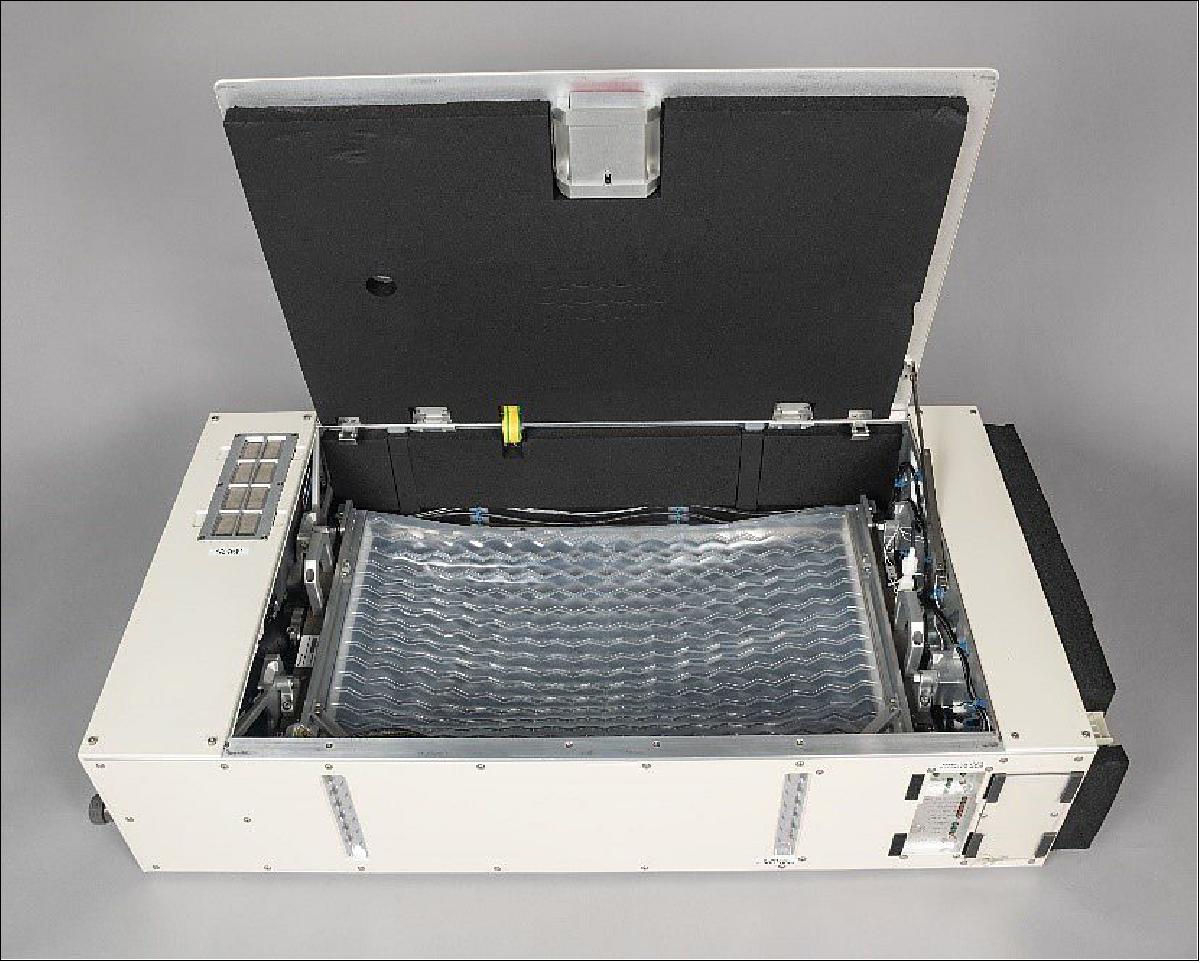
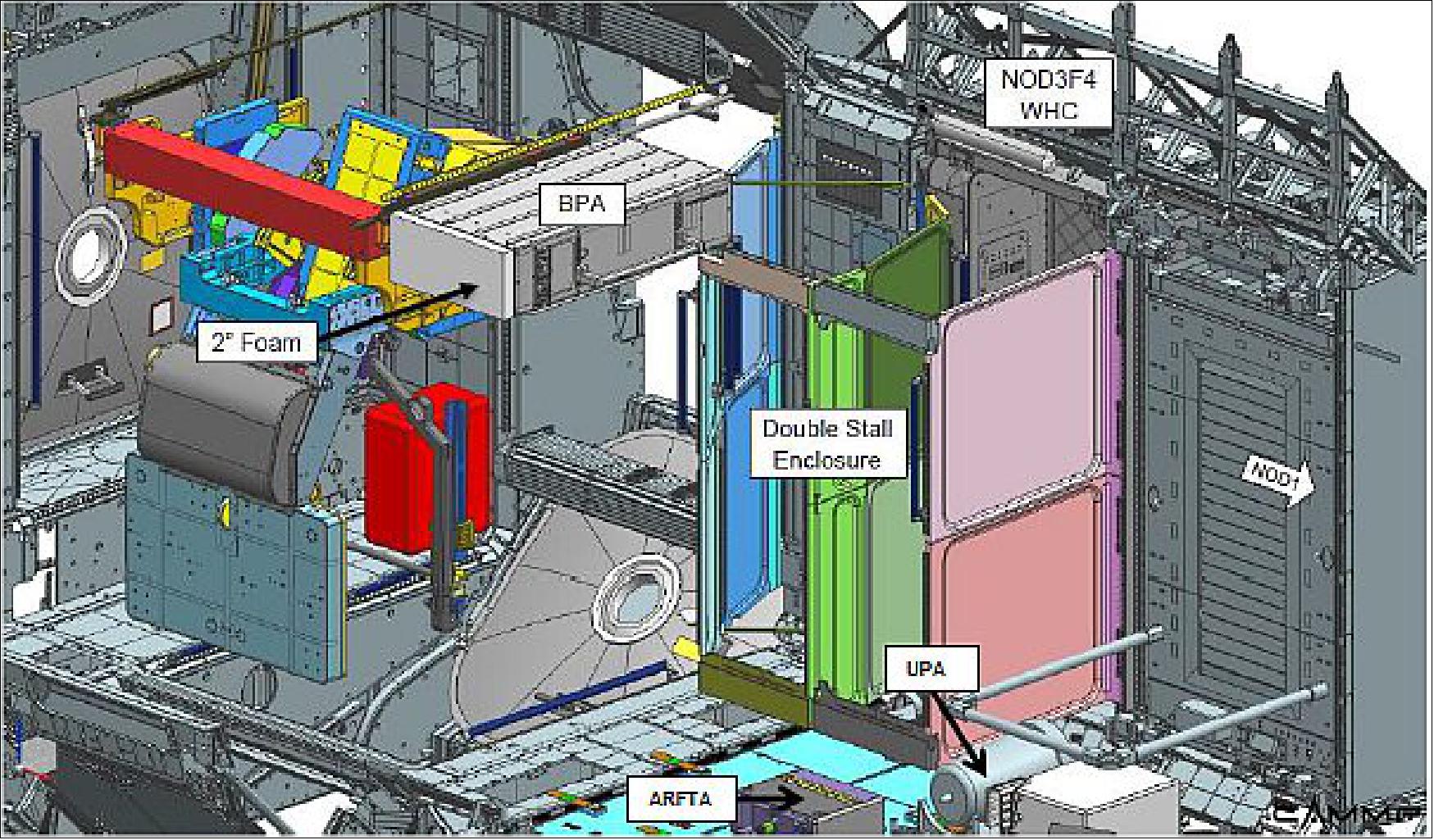
The brine processor ultimately will help enable long-duration crewed exploration missions and reduce the need for water resupply from Earth. The technology demonstration's ability to improve the recovery of water from urine brine also has potential use on Earth in harsh and remote settings with limited access to water.
Paragon Space Development Corporation of Tucson, Arizona, developed this technology demonstration in cooperation with NASA's Johnson and Marshall Space Flight Centers.
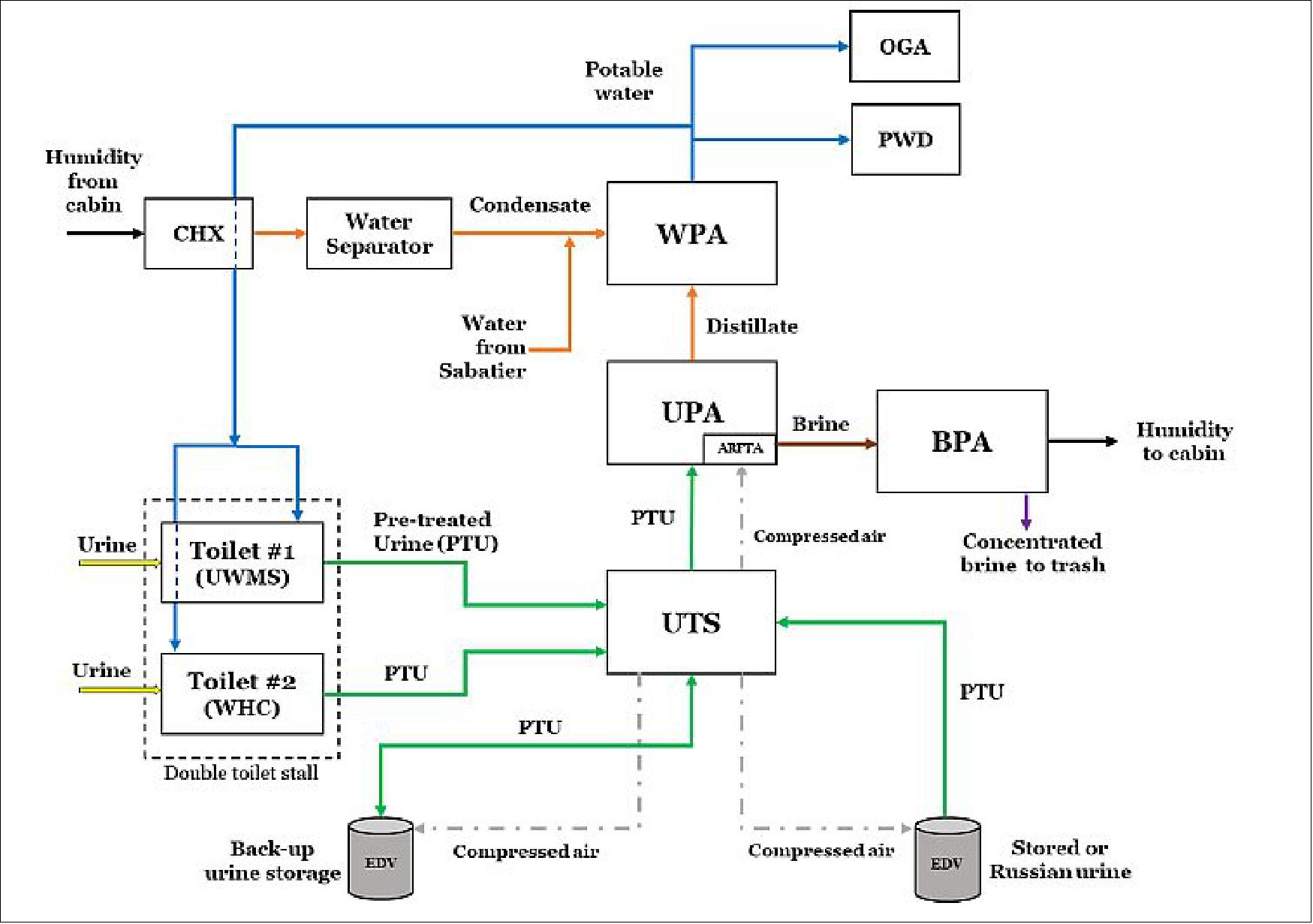
References
1) "NG-15 Mission - Delivering Cargo to the International Space Station," Northrop Grumman, 2 February, 2021, URL: https://www.northropgrumman.com/wp-content/uploads/NG-15-Mission-Profile-Handout.pdf
2) Monica Witt, Stephanie Schierholz, Leah Cheshier, Keith Koehler, "NASA Science, Cargo Launches on 15th Northrop Grumman Resupply Mission to Space Station," NASA Press Release 21-019, 20 February 2021, URL: https://www.nasa.gov/press-release/
nasa-science-cargo-launches-on-15th-northrop-grumman-resupply-mission-to-space-station
3) Stephen Clark, "Antares rocket launches heavy cargo load to International Space Station," Spaceflight Now, 20 February 2021, URL: https://spaceflightnow.com/2021/02/20/
antares-rocket-launches-heavy-cargo-load-to-international-space-station/
4) Stephanie Schierholz, Monica Witt, Keith Koehler, "NASA TV Coverage Set for Next Cargo Launch to Space Station," NASA Press Release, 12 February 2021, URL: https://www.nasa.gov
/press-release/nasa-tv-coverage-set-for-next-cargo-launch-to-space-station
5) "Several Technology Development Payloads Sponsored by the ISS National Lab Launching on Northrop Grumman CRS-15," SpaceRef, 17 February 2021, URL: http://www.spaceref.com
/news/viewpr.html?pid=56994
6) "Paragon delivers key life support system to ISS," Space Daily, 25 February 2021, URL: https://www.spacedaily.com/reports/Paragon_delivers_key_life_support_system_to_ISS_999.html
7) Debra Werner, "Toast-shaped ThinSats attract educational and government customers," SpaceNews, 22 February 2021, URL: https://spacenews.com/thinsat-second-constellation/
8) Hillary Meyerson, "SEOPS-3 / NG-15 To Launch This Weekend," Spaceflight, 16 February 2021, URL: https://spaceflight.com/seops-3/
9) "Tel Aviv University nanosatellite reaches orbit," Tel Aviv University, 22 February 2021, URL: https://www.jns.org/tel-aviv-university-nanosatellite-reaches-orbit/
10) Mark Garcia, "Cygnus Resupply Ship Bolted to Station's Unity Module," NASA Space Station, 22 February 2021, URL: https://blogs.nasa.gov/spacestation/
2021/02/22/cygnus-resupply-ship-bolted-to-stations-unity-module/
11) Debra Werner, "Spaceborne Computer-2 shows results on space station," SpaceNews, 18 August 2021, URL: https://spacenews.com/spaceborne-computer-2-first-results/
12) "Northrop Grumman's NG-15 Cygnus Spacecraft Departs International Space Station to Begin Secondary Mission," Northrop Grumman, 29 June 2021, URL: https://news.northropgrumman.com/news/releases/northrop-grummans-ng-15-
cygnus-spacecraft-departs-international-space-station-to-begin-secondary-mission
13) "New Technology Demonstration and Facility Installed on the Space Station to Enable Future Research," ISS National Laboratory, 7 May 2021, URL: https://www.issnationallab.org
/iss360/iss-tech-demo-facilities-installed-icf-sbc2/
14) "Nanoracks Launches Two CubeSats on NG-15 Cygnus," Nanoracks, 22 February 2021, URL: https://nanoracks.com/nanoracks-launches-on-ng-15/
15) Reiley Doty, Mark Garcia, "New Brine Processor Increases Water Recycling on International Space Station," NASA Feature, 25 February 2021, URL: https://www.nasa.gov/feature/
new-brine-processor-increases-water-recycling-on-international-space-station
The information compiled and edited in this article was provided by Herbert J. Kramer from his documentation of: "Observation of the Earth and Its Environment: Survey of Missions and Sensors" (Springer Verlag) as well as many other sources after the publication of the 4th edition in 2002. - Comments and corrections to this article are always welcome for further updates (eoportal@symbios.space).